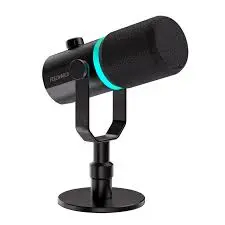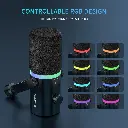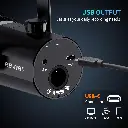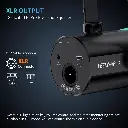Here’s a detailed breakdown of the FEELWORLD PM1 XLR/USB Dynamic Microphone — what it offers, what to watch out for, and product/price options in India. Happy to compare vs a competing mic if you like.
🎙 Key Specs & Features
From official FEELWORLD/retailer sources:
Newegg.com+4Amazon+4B&H Photo Video+4
| Feature | Detail |
|---|---|
| Mic Type | Dynamic capsule, cardioid polar pattern. This helps reject off‑axis / background noise better than many condensers. B&H Photo Video+1 |
| Frequency Response | 50 Hz to 14 kHz — good for vocals, speech, streaming, gaming etc. Amazon+2B&H Photo Video+2 |
| Sensitivity | −54 dB ±1.5 dB (0 dB = 1 V/Pa at 1 kHz) Amazon+1 |
| Signal‑to‑Noise Ratio (SNR) | ~ 95 dB teltec.de+1 |
| Output Impedance | ~ 600 Ω Amazon+1 |
| Bit Depth / Sample Rate | 24‑bit / 96 kHz (in USB mode) Amazon+1 |
| Interfaces | USB‑C (plug‑and‑play) + XLR output + 3.5 mm headphone jack for monitoring. Amazon+2Target+2 |
| Controls / Extras (USB mode) | |
| • Mute key (front touch) — tap to mute, light turns red to indicate mute. Amazon+1 | |
| • Volume knob to control mic or headphone levels (in USB mode) — short/long presses change modes. Amazon+1 | |
| • RGB lighting ring with gradient effects. Adorama+1 | |
| What’s not available in XLR mode | RGB lighting, mute key, volume knob monitoring etc. Basically many of the “USB conveniences” are disabled when using XLR. You must control via the connected preamp/interface in XLR mode. Adorama+1 |
| Build / Form | Metal body, includes anti‑spray foam/windscreen. Boom arm or desktop stand options exist (e.g. the PM1‑AS bundle) for different setups. B&H Photo Video+1 |
✅ What It Does Well / Good Points
Being a dynamic mic, it naturally rejects background noise better than most small condensers — good for streaming, gaming, podcasting from not‑perfect rooms.
Having both USB‑C + XLR outputs gives flexibility: you can plug into PC/phone easily via USB, or upgrade your rig (interface/mixer) via XLR for potentially better sound.
Real‑time headphone monitoring via 3.5 mm jack in USB mode, plus mute/volume controls, make it convenient for live‑streaming / voice work.
The RGB light & mute indicator are nice touches for streamers wanting visual feedback.
Generally good value: specs like 50‑14 kHz frequency response, 24‑bit/96 kHz in USB mode, metal build, etc., are better than what many budget mics offer.

⚠️ Limitations / What to Watch Out For
When using XLR mode, many of the goodies (RGB, mute button, volume knob, monitoring) are disabled. So if you use XLR often, you’ll lose some convenience. Adorama+1
Frequency response maxes at 14 kHz — for most speech/voice work this is fine, but audio “air” (very high‑end sheen) beyond that may be lacking compared to more premium mics.
Dynamic mics require you to speak relatively close to the mic to get clean, strong signals — may need to position well (like 2‑6 inches). Gain on your interface or USB input will matter.
RGB lighting / electronics may introduce physical noise or interference if cable / grounding isn’t good — real world performance may vary.
Price vs what you may get from simpler USB mics or well‑known brands: sometimes trade‑offs in preamp quality, headroom, brand support, durability.











